It’s rewarding to step back sometimes and view quilting as part of a bigger world, which is what New York Times best-selling author Sandra Dallas does in some of her books, including The Persian Pickle Club, a murder mystery set during the Depression in the Midwest. The book weaves together the lives of a group of women in Kansas who all belong to a quilting club. Although they are very different, sewing brings them together.
Writer Linda Bonniksen-Hamlin, a regular contributor to Generation Q Magazine, shares in our current March-April 2014 issue about Christine Fiore’s efforts to bring The Persian Pickle Club to the big screen.
Meanwhile, associate editor Tracy Mooney got a few moments with Sandra Dallas at a recent book event in Tracy’s hometown. Let’s listen in….
Sandra: In the 19th century, women were not encouraged to pursue fine arts. So they put their art into every day work like quilting. You could think of quilts of great big squares of fabrics and it was perfectly serviceable. Instead they cut them into little shapes and made works of art out of them. And I like that. I like the stories of quilts. Today, so many quilts are perfect. I have a baby quilt that (is made of) pink, cheddar yellow and brown. And right in the bottom is a little piece of blue where she ran out of fabric. So there are wonderful stories you can make up about it. I was never a very good quilter…
Tracy: You were never a very good quilter?
Sandra: No. Well, actually I was considered a very good when I quilted because nobody else quilted. Once I started, it was pretty obvious I was not very good.
Tracy: And I think some are gifted storytellers and that’s your art.
Sandra: I would like to think so – quilting with words instead of thread.
 Tracy: In Persian Pickle, I was fascinated with how you wove the quilts into the story and even just a mention of a particular (quilt). As a quilter I’ve had an instant image of what the quilt was and maybe the average person reading may not get that visual image like I had when reading it, but it definitely helped put me into the time of the story.
Tracy: In Persian Pickle, I was fascinated with how you wove the quilts into the story and even just a mention of a particular (quilt). As a quilter I’ve had an instant image of what the quilt was and maybe the average person reading may not get that visual image like I had when reading it, but it definitely helped put me into the time of the story.
Sandra: Quilters are very loyal and they’re good readers and I’ve put quilts into a lot of my books. I’m not a quilt novelist and I fight that designation. I’m a novelist who happens to like quilts. My books are more hard-edged than quilt novels. I don’t have quilts in all of my books (but) I love the vehicle of a quilting circle. If I were to write a book about contemporary times, it would probably be a quilt group. Quilting was quintessentially female. It’s a way women bond. They pull together in rough times. In good times they might not be so close. In difficult times they’re there. And you have all kinds who make up a quilt circle. You can have one who’s rich and one who’s poor and one who’s loud.
You can also tell about women’s personalities with the way they quilt. Somebody who uses browns is very different than a character who uses primary colors. Someone who takes very neat tiny stitches had a different personality than someone with big, sloppy stitches
Tracy: That’s very true.
Tracy: So my next question you’ve already answered. What drew you to quilting in the books? I find it fascinating that you use it in the books to help weave the story. Do you think had you not quilted yourself would you have used quilts in your story?
Sandra: I think because I’ve always sewn and because I’ve quilted I probably have a better understanding of the mechanics of quilting. How you lick the thread before you put it through the eye of the needle. How you hold the needle if you can’t see very well you might hold the needle at a different angle. How you can prick your finger. How you use a thimble. I’m sure that because I’ve done some quilting and because I sew, it gives a certain authenticity to the writing
Tracy: What other types of things do you sew?
Sandra: Well, when I was growing up if you wanted clothes you had to make them yourself. So I made all of my clothes when I was young. And I’ve done needlepoint and different handcrafts. I don’t much anymore. In my generation you sewed. It was just like cooking. You had to take it in school. It was required so we all learned how to sew. I like quilting. I love fabrics. I love the feel of fabrics. You can’t walk into a fabric store without touching. I love the look of them.
And when I travel I like buying fabrics. I do a little quilting. I buy old quilt tops and quilt them. Sometimes they’re for single beds and so I make them larger and add strips and buy old fabric to do that. I go into fabric stores when I’m different places. And just love to look at it. I buy old quilts and quilt squares at antique shops and the Houston Quilt Festival. And I always think I’m going to make a quilt. And I do put them together . I do a little bit of quilting. I shouldn’t say I don’t quilt (but) I’m not a quilter the way you are.
Tracy: Obsessed is what I am
Sandra: I collect doll quilts. I have quite a few of those. And I buy old quilts. I’ve given several to the Rocky Mountain Quilt Museum. I was on the board of the Quilt Museum for several years.
Tracy: Where did you grow up?
Sandra: Denver. I was born in Washington, D.C. I grew up in Colorado and Utah.
Tracy: Do you know how many of your books feature quilts?
Sandra: More than half. Out of 13 books including the children’s book, I would say 1/3 of them have a lot of quilting and 1/3 have some mention of quilting. There are a lot of fiction books now about quilts. Clare O’Donohue (do you know her she lives here?), Marie Bostwick, Arlene Sachitano, Jennifer Chiaverini, Emily Richards… I’m really in a different category from them because they tend to write more about quilting. In my books, quilts are an element of the books…
When Persian Pickle Club was published, the only other quilt book I knew was How to Make an American Quilt. That came out when I was writing the first draft of my book. And then I think the quilting thing came on about that time or shortly afterwards.
Tracy: So you’re a trendsetter!
Sandra: Well, I don’t know. I’m older than the rest! I think that explains the difference.
You can learn more about Sandra on her website . Pick up a copy of our March-April 2014 issue to learn more about the movie project featuring Sandra’s book, or visit the movie’s website.

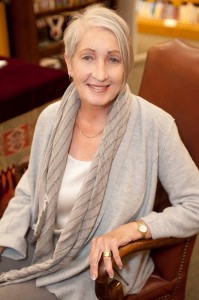
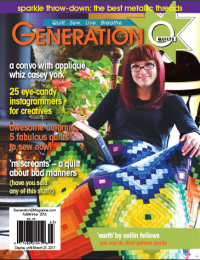
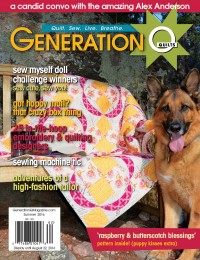


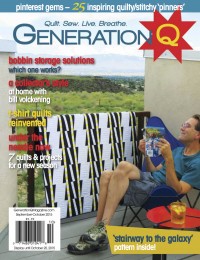
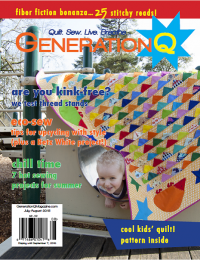
COMMENT #1
I’ve moved and did not give you my change of address and I’m not receiving my magazines. Is there a phone number to call to change my address? Help!
COMMENT #
Hi, Virginia, Jake FInch manages our distribution and mailing. You can send new address info to her at jake@generationqmagazine.com. We’ll get you fixed up!
COMMENT #2
Thanks for this wonderful interview! I suspect that she’s a better quilter than she thinks, don’t you?